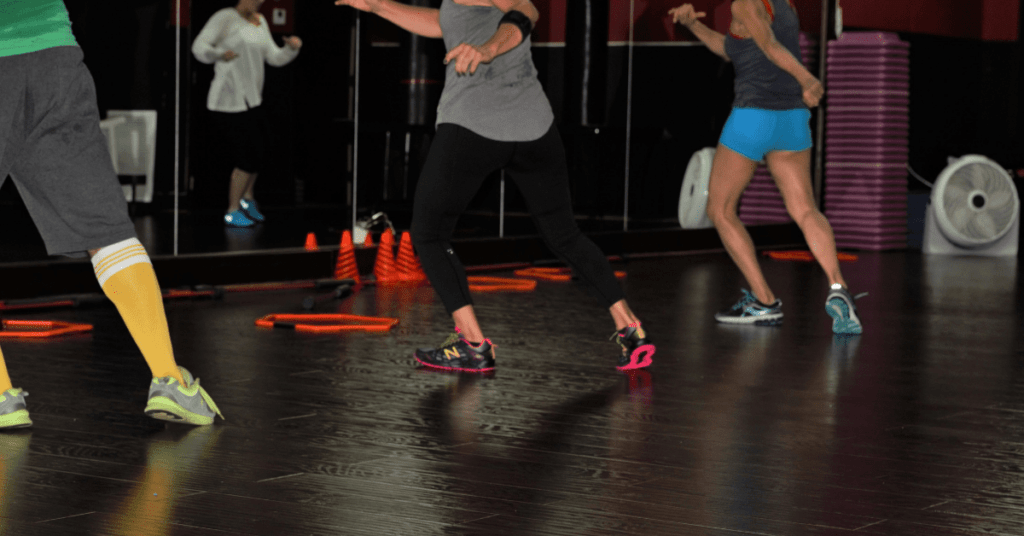Whether you’re running in-person classes, virtual ones, or both, you want to fill out your classes. Class attendance is a huge part of whether the program is a success or not. Growing and consistent attendance is key to overall success, revenue, and a steady workflow.
The coronavirus pandemic accelerated online workout classes. Most fitness brands need to think about how to increase group attendance in both virtual and in-person classes. Great customer experience and ongoing engagement are essential in keeping members committed to classes. In this article, we talk about how group fitness is changing in 2021 and specific tactics you can implement to increase group fitness attendance.
Skip ahead to:
- Group Fitness, Covid-19 and the Fitness Industry
- The Group Fitness Trends That Will Be Popular This Year
- How Group Fitness Will Change in 2021
- 9 Ways to Maximize Your Group Fitness Class Attendance
Group Fitness, Covid-19 and the Fitness Industry
Statistics show that 44% of respondents in the United States were a little nervous about taking part in group fitness as the coronavirus situation improved. What’s more, is that 28% of people asked said they were very nervous to join a group fitness activity.
The Covid-19 crisis has pulled focus on physical and mental health. Virtual fitness classes and mental health options are skyrocketing in popularity. Many businesses have adapted to a new mindset and responded to the pandemic by delivering digital fitness solutions. Now, as the vaccine program continues to roll out and restrictions begin to ease, will digital fitness become part of the fitness landscape for the foreseeable future?
Remote and online fitness offers a convenient and flexible solution. As the demand for online classes is yet to slow down, digital fitness classes will likely form part of your greater class offerings. A hybrid approach to fitness is in demand. Members want complete flexibility with home fitness complementing existing gym services.
The Group Fitness Trends That Will Be Popular This Year
While it’s not possible to predict the future, there are certain trends in the world of group fitness that continue to stay popular year on year. When you combine changing consumer priorities and behaviors, group fitness remains a way to both connect with people and stay fit and healthy.
Group exercise and high-intensity interval training continue to be popular because of the many benefits that come from working out in a group. While some people love to head to the gym alone and sweat through a training session, there is a power that comes with working out in a group. Often, members feel more motivated and accountable working out together. This encourages them to keep going and, eventually, lead to increased results and performance.
Training that connects mind and body will continue to grow. Trends are leaning more towards activities like yoga, Pilates, and mental training such as meditation. More and more people are looking to combine physical and mental activities to combat work stress, financial stress, and enhance overall wellness.
The pandemic has turbocharged the adoption of digital fitness, apps, and virtual training as an effective form of fitness. While you could access digital training before the pandemic, you didn’t have the level of competition that you now have. It’s becoming an expectation that gyms and health clubs will run both digital and in-person classes.
Another group trend you’re likely to see more of this year is outdoor group classes. According to RunRepeat, 39.4% of gym members are switching to outdoor activities in 2021. Fresh air circulation and the ability to social distance make outdoor classes very attractive. However, you do have to rely on the weather which may not be ideal for all locations.
No doubt, this year there will be a continued focus on community. With targeted group exercise classes on the rise, fitness classes will delve deeper into a niche by serving a more specific target customer base. While all around fitness will always be present, brands will continue to niche down and attract customers with tailor-made offers and personalization.
How Group Fitness Will Change in 2021
Whether you’re running at a reduced capacity or still experiencing closures, as group fitness classes reopen around the world, there will be some changes. These changes are driven by the pandemic and need to be addressed so that you can reassure members that it’s completely safe to return to group fitness.
Social Distancing
You will need to think about how you will allow for social distancing during fitness classes. This will help to reassure members that there is plenty of space to work out without getting too close to other people. Although a major benefit of group fitness is a sense of community and human connection, social distancing and COVID-19 protocols will likely play a big part in the decision-making process for members going forward.
Reduce Touchpoints
It’s important that you reduce touchpoints and minimize the use of shared items. This is easier for some types of fitness classes than others. For example, a yoga studio can ask members to bring their own mat, blocks, and towel. That way, students can use their own items and take them home after. There is no shared equipment at all. However, with a weight class, it’s obviously difficult to bring your own weights. For essential equipment, you will need to clean it between uses, ready for the next class.
The Top 10 Barriers
Slowing Your Fitness
Business Growth
Discover more Class Scheduling
Another area that may need to change is your class scheduling. You will need to allow for plenty of time to clean, disinfect and sanitize between classes. This is especially important if members are sharing equipment. It also gives members enough time to leave before your new group comes into the fitness club. That way, you don’t have groups of people waiting indoors.
The Fitness Founders Podcast has an interesting episode on reopening your gym successfully and safely. This is a recording from one of our roundtables at last year’s Glofox Connect. On this panel, various fitness industry experts and operators delve into the topic of safety and the steps you need to think about when running a gym in a pandemic.
9 Ways to Maximize Your Group Fitness Class Attendance
Many factors contribute to consistent and high group fitness class attendance. Often, there isn’t just one thing that will improve attendance. Instead, you can implement several methods that combine to create a better experience and attract your ideal customers. If you want to achieve long-term success, maximizing your class attendance is key. Here are nine ways to increase attendance and optimize the fitness class schedule.
1. Invest in the Right Talent
Your fitness instructors can be a defining factor in the success of your class. Are you hiring instructors with the right qualities? You need instructors with the right skills to deliver incredible virtual and in-person classes. Great fitness instructors make a class unique, connect with students, and run classes correctly. When hiring good talent, look out for the right qualifications as well as personality traits that make them likable and stand out.
2. Create a Smooth Class Sign-Up Experience
The journey from signing up and paying for a class to attending should be seamless. Streamline the sign-up and payment process to avoid any payment problems. Your sign-up process should be clear, seamless, and flexible. Include different payment options to suit your members and offer complete convenience. Your sign-up process is part of your greater customer experience.
A good fitness membership management software can organize classes and ensure a smooth digital experience. When the entire class process is easy, it doesn’t leave room for frustration. For example, if you only take one form of payment, you narrow down your clientele.
3. Effectively Market Your Fitness Class
For new members to come to your class, they need to know it exists. Marketing your group fitness classes effectively can help to increase attendance and build awareness. Whether your marketing online classes or in-person, it’s important to promote and market your services to the right people. Show your value proposition, leverage your existing members, and use social media advertising and marketing to attract new customers. Your marketing strategy should utilize an omnichannel approach so that your messaging is consistent throughout your business.
4. Analyze Your Class Data
Analyze your past member attendance reports and evaluate your current data. By making data-driven decisions, you can invest your time and resources effectively to get the biggest return on investment. When you look at your class data, you may find that certain days and times are just not working for you. But, on other days you’re fully packed with a waiting list. By readjusting your class schedule, it could lead to better attendance. You may find that certain types of classes are more popular than others. In this case, you may benefit from removing classes that have stagnated and introducing in-demand fitness styles and instructors.
5. Offer Incentives
Member incentives can do wonders for member acquisition and keeping attendance high. For example, you can offer members a free class pass for their next workout class. That way, you not only encourage members to attend a class but to bring a friend who could end up being a member as well. When used correctly, member incentives and referrals can encourage members to show up for class, increase motivation, and boost performance. Other ways to incentivize your members include a rewards program, early booking bonuses, and birthday gifts.
6. Provide Virtual Group Fitness Classes
If you don’t already offer virtual fitness classes, now is the time to start. To have a competitive edge and meet consumer expectations, a digital fitness platform is a must. By offering virtual fitness options, you open the door to a ton of opportunities. Your digital arm doesn’t compete with your fitness facilities. Instead, virtual fitness compliments your in-person offering. It creates an offer that is completely convenient and flexible while retaining the human connection and benefit of working out at a facility.
7. Send Useful Class Reminders
It’s easy to forget about your class. When you book training sessions in advance, you can quickly forget and sometimes cancel if something else has come up. To streamline the class process, automate class reminders. This would include booking confirmation followed by a class reminder the day before the class. Include a motivational message within the reminder that encourages members to show up for themselves, put the work in, and get results. By automating email, text, and push notifications, you can streamline the entire booking experience.
8. Run a Fitness Challenge
Sometimes a drop in attendance is linked to a dip in motivation. Naturally, motivation ebbs and flows. A fitness challenge can increase motivation and create a sense of competition. You can run both in-person and virtual fitness challenges to inspire your members to get moving. Fitness challenges can be as simple as most classes attended to an eight-week tailor-made program for users. Fitness challenges are another way to incentivize members to show up and nurture a thriving gym community. You can tap into different niches depending on your fitness challenge from weight loss and improving fitness to getting a new personal best.
9. Inspire and Motivate Members
It’s important to keep your classes exciting. Stay ahead of the competition by introducing innovative fitness class ideas. One way to keep members motivated is through a variety of training styles. It’s easy for classes to become stale and boring. Sometimes, it’s a good idea to step away from traditional fitness types and try something new. Leverage technology to streamline fitness and increase the member experience.
Ian Mullane, the CEO of Keepme, talks about the new rules of engagement in the fitness industry in an episode on The Fitness Founders Podcast. He talks about how to increase member retention through personalization and the importance of consistency in the member journey.
In Summary
By hiring the best fitness instructors and creating a unique class experience, you’re well on your way to increasing group attendance. Whether you need to re-organize your class schedule or improve member engagement, there are several things you can do to increase group attendance for long-term success.














